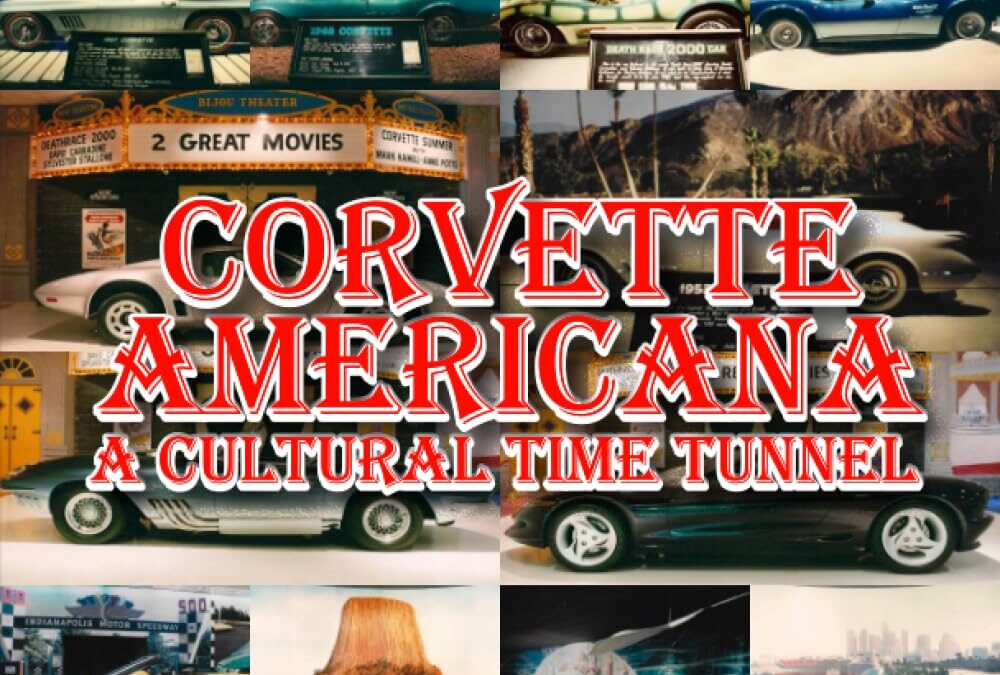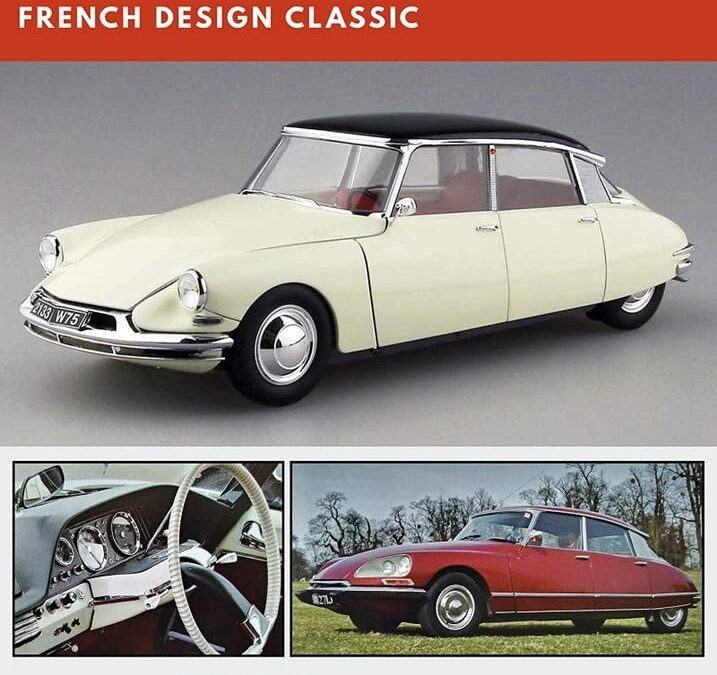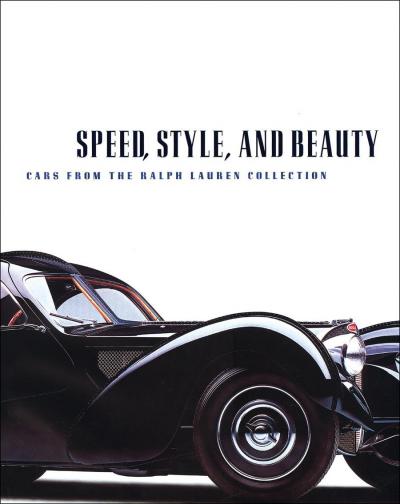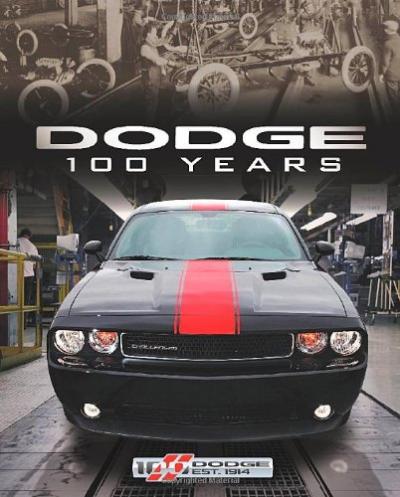
Allen Schery is perhaps the first Anthropologist to have designed a Car Museum. Prior to his design we generally only see rows of cars with small signs. Allen’s unique idea was to place each car in a set featuring a giant 15 x 30-foot photo mural that utilized a curved dioramic wall to give a 3-D effect incorporating a symbol of American Culture as a backdrop. Allen then took several trips around America logging in some 20,000 miles of trips procuring pictures of Mt. Rushmore, Niagara Falls, The Golden Gate Bridge, the Alamo, and other well-known American Landmarks. Each set featured real earth scenes and stage lighting. The Corvette was used as a time-coordinated symbol of American Culture to anchor the exhibit. He then theorized that as the original owner of each car placed the key in the ignition he was surrounded by the culture of a bygone year of Americana. He sought to recreate the sights. sounds and memories of that bygone culture by using the music, television, and movie snippets of that year along with slides of news events and time-coordinated artifacts. The Museum won many awards as well as being chosen as one of the ten best museums in New York State. Each room became a time capsule to that year with the entire museum a giant time tunnel.

Launched in 1955 yet looking like a sci-fi design proposal for a future then undreamed of, Flaminio Bertoni’s ellipsoid sculpture with wheels that was the Citroën DS stunned the world.
There was a near riot at the 1955 Paris Motor Show launch of the car, orders flooded in for this, the new ‘big Citroën’ (a Voiture a Grande Diffusion or VGD) as the car that replaced the legendary Traction Avant range.
The term ‘DS’ stems from two Citroën parts of nomenclature – the type of engine used as the 11D, (D) and the special hemispherical design of the cylinder head as ‘Culasse Special’ (S): DS out of ‘Deesse’ or Goddess, was a more popular myth of ‘ DS’ origination, but an erroneous one.
But it was not just the car’s aerodynamically advanced body shape (Cd. 0.37) that framed the genius of the DS: hydro pneumatic self-levelling suspension, advanced plastics and synthetics for the construction of the roof and dashboard/fascia, and amazing road holding and cabin comfort were some of this car’s highlights.
Only the lack of an advanced new engine was deemed a missed opportunity. In fact Citroën had created a new engine for the car but lacked the resources to produce it in time for 1955.
DS was a major moment in the history of car design, one so advanced that it would take other auto manufacturers years to embrace. Yet DS in its ‘aero’ design was the precursor to today’s low drag cars of curved form.
Manufactured worldwide, used by presidents, leaders, diplomats, farmers and many types of people, the DS redefined Citroën, its engineering and design language, and its brand, for decades to come.
Prone to rust, not the safest car in the world, and always lacking a smoother powerplant, the DS still became an icon of car design.
Reshaped with a new nose and faired-in headlamps in 1967, DS remained in production until 1975.
Across its life DS spawned an estate car variant as the ‘Safari’, a range of limousines, two-door convertibles, and even coach-built coupes and rally specials.
This car was a product design that became an article of social science – it was that famous and it defined a European design movement upon a global stage then packed with ‘me too’ copyist designs.
The DS or ‘Goddess’ as it was tagged, was a tear-drop shaped act of French confidence in a world of the regurgitation of the known. Some argue that DS and its effect has never been surpassed.
This new value-for-money book provides innovative access to the design, history, and modeling of the revolutionary DS – one of the true ‘greats’ of motoring history and, a contemporary classic car of huge popularity.

Richly illustrated and entertainingly written, The Big Book of Tiny Cars presents lively profiles of the automotive world’s most famous—and infamous—microcars and subcompacts from 1901 to today.
From tiny homes to little lending libraries and even tiny food, people everywhere are resetting the premium they put on size. Fact is, the automotive industry has a “tiny” history going back to the car’s earliest days.
Beginning with the Curved Dash Oldsmobile and continuing through prewar classics such as the Austin Seven and Hanomag Kommissbrot, The Big Book of Tiny Cars is truly international in scope. Witness diminutive cars like the Bond Minicar and the BMWIsetta introduced to fuel-deprived postwar Europe, and continue through the classic 1950s microcars and ’70s subcompacts, right up to today’s tiny cars and electric vehicles (EVs) fromthe likes of Smart and Fiat.
In addition to iconic curiosities like the frog-like Goggomobil Dart, the futuristic Sebring Vanguard Citicar, and the three-wheeled Reliant Robin, you’ll read about more familiar classics like the VW Beetle, MiniCooper, and Crosley Super Sport. Other manufacturers represented include Honda, Datsun, Mitsubishi, Trabant, Heinkel, Renault, and Messerschmitt, to name a few.
- Each car is profiled with an entertaining and informative history and a fact box.
- Imagery includes archival photos, period ads, and modern photography.
- In all, more than 100 cars are included, from the weird to the sublime.
Gas, diesel, or electric…tiny cars have a rich and curious heritage reflective of motorists’ concerns for their pocketbook, the environment, or both. The Big Book of Tiny Cars is your ultimate collection of microcars, minicars, bubble cars, kei cars, subcompacts, and compacts that have been built, sold, and driven all over the globe for 120 years.

Dodge had a very successful year in 1964. Performance V-8s ranged from 265 to 425 horsepower, & the option list in 1965 provided ‘426 Hemi V8s, floorshifts and consoles. Model output for that year was more than 475,000 cars. In 1969 big styling changes were reserved for the Polarna/Monaco full-sized models which had smooth, convex body sides and curved ventless side window glass. By 1970, Dodge continued to emphaize sportiness and performance by introducting its all-new Challenger.
This portfolio includes 32 articles covering the Polarna, Dart, 880, Coronet, Monaco, Charger, Super Bee, Daytona, Challenger, & Demon. Includes road & comparison tests, model introductions, specification data, and racing.

General Motors wanted to revolutionize transit bus design after having success with their New Look Bus through the 1960s. Being protagonists for progress, GM’s engineers created a prototype coach that would address all of the New Look’s shortcomings. This RTX (Rapid Transit Experimental) was a shock to the transit industry, and it wasn’t until 1977 when the better-developed RTS bus became part of the Advanced Design Bus project and was the descendant of GMC’s entry in the U.S. DOT’s ‘Transbus’ project. The RTS is notable for its curved body and window panels and has become recognized as a timeless design just like the GM New Look was. In 1987 the RTS patents were sold to Transportation Manufacturing Corporation (TMC) and then they sold the rights to NovaBus in 1994 who left the U.S. market in 2002. However, Millennium Transit Services has since revived the RTS in 2006. Here it is, the only book with the full in-depth history that is also well illustrated with time-period photography and a color section.

Bugatti and Bentley, Alfa and Aston, Mercedes and McLaren-these are not merely cars, they are some of the most exquisite automobiles ever assembled, selected by Ralph Lauren, one of the foremost designers of our time. This breathtaking volume features 29 of these wonders-from such unparalleled masterpieces as the 1930 Mercedes Benz “Count Trossi,” the 1938 Alfa Romeo Mille Miglia, and the 1938 Bugatti Atlantic Coupe to marvels from Jaguar, Aston Martin, Ferrari, Porsche and even a Ford “Woody”-each of these vehicles is lovingly photographed and presented with authoritative elegance. Complementing the images are sketches of these and other cars-rarely seen drawings that give insight into the conceptual and development stages of the automobiles. Now in its fourth printing, Speed, Style, and Beauty is the first book on cars to center its discussion squarely on the car’s role as an art object. The 29 chapters, by two of the best known and most respected authors writing about cars today, gives the indispensable background information, but also approaches the cars the way an art historian would approach fine sculpture-treating them as consummate works of decorative art for the modern age. With over 160 color images by world-renowned photographer Michael Furman, plus an introductory interview with Ralph Lauren who discusses the links between the cars and his overall design philosophy, this is an elegant yet informative book that will delight both the rampant car enthusiast and aficionados of great design in any form. The sleekly curved chrome and steel of these timeless dream machines conjures the glamour of the 1930s, the opulent ease of the 1950s and the charged excitement of the 1980s-the perfect marriage of speed, style and beauty.

“It was 1900 when Horace and John Dodge founded the Dodge Brothers Company, in a machine shop in Detroit, Michigan. The high-quality components they produced advanced the dawn of the American automotive industry, appearing in the famous Curved Dash Olds and Henry Ford’s Model A. Soon, the brothers became the exclusive supplier to Ford, a position they would hold for over a decade before striking on their own in 1913 to produce their first car a year later.
In Dodge 100 Years, renowned automotive journalist Matt DeLorenzo provides an unrivaled chronicle of Dodge throughout the past century. Starting with the company’s modest beginnings in the 1900s, DeLorenzo recounts the brothers’ decision to venture into full auto manufacturing, their untimely deaths in 1920, and the company’s purchase by Chrysler in 1928. The book’s rich history also tells the tale of Dodge’s role in the “arsenal of democracy” during World War II and its iconic lineup during the late 1950s. The Dodge story is not without its struggles, though: while the division played a key part in the muscle-car wars of the 1960s and early ’70s, the oil crisis of 1973 took its toll on Dodge and Chrysler as other manufacturers moved toward more efficient models. But under the strong leadership of Lee Iacocca from 1979 onward, Dodge reasserted itself with such vehicles as the K-car and the Caravan minivan. The Dodge story wouldn’t be complete without speaking to its iconic performance cars like the Viper, Challenger, and Charger, as well as what’s in store for its future as indicated by the innovative Dart. Dodge 100 Years is more than a tale of classic American perseverance; it is a celebration of one of America’s most beloved and enduring automotive brands.
”









